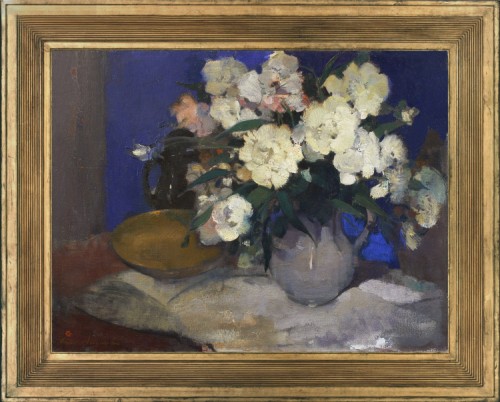A swooping, sensuous mass of graphically brushed-in flowerheads, this perfectly choreographed arrangement arcs across the canvas, the colour of the white petals shading from dull turquoise and stone in the shadows to coral pink lit with almond green. Swyncop produced several of these unusual flowerpieces in a landscape format, which give an unexpected importance and immediacy to an apparently simple subject. They convey the impression of rapid execution, but are expertly judged in terms of form and colour. Texture is important to this particular flowerpiece; the glossy surface of the pitcher contrasting with the rough linen it stands on; the dull gleam of tarnished brass, and the fragile, blowsy softness of the flowers.
Biographical details
Charles Swyncop was a Belgian painter, designer and print maker, born in Brussels in 1895. He studied first under his elder brother, Philippe (who was 17 years older than Charles), and who was an engraver, a graphic artist decorative painter. Like his brother, Charles then moved to the Brussels Academy of Fine Arts, where his teachers were Jean Delville, Herman Richer and Alfred Bastien, and where he won third place in the Prix de Rome of 1920.
After studying in Rome he joined some of his fellow students in Brussell to work, under their teacher, Bastien, on the vast Panorama of the Battle of Yser. Bastien had worked as a sort of unofficial war artist from 1915, much of his work being published in the British Illustrated War News, some of it in the form of large semi-panoramic double-page spreads. After the war, he translated his sketches and photos into the Panorama de l’Yser, which measured 115 metres by 14 metres. It was exhibited initially in Brussels, where it was seen by more, it is estimated, than 800,000 visitors, and then transferred to a purpose-built gallery in Ostend.; it was badly damaged in a bombing raid in 1940. The group of ex-students and Bastien’s war-time colleagues, incuding Charles Swyncop, who worked on the project, took a year to complete it.
Later in the 1920s Swyncop travelled to Italy again, Venice and Spain, where his brother lived for twelve years, and where he produced work in various genres – portraits, figure paintings, still life, landscapes and marines.
Again with Alfred Bastien, and other artists such as Jules Brouwers, Swycop joined the group La Lierre, exhibiting with them at the Toison d’Or in Brussels. He also took part, with his brother, in a group exhibition at the Maison d’Art Moderne in Brussels in 1920. In 1930 he was commissioned by the Belgian State to paint decorative panels for a pavilion at the Exposition Universelle of 1930 in Antwerp. He exhibited at various salons, including the 1933 and 1937 Salons at Ghent. In 1938 he became a teacher at the Academy of Fine Art in Ixelles, where he remained until his death in 1970; his pupils include Isi Koslowitz, Charles Delaite and Doris Kiesewetter. In 1963 he illustrated the cover of the cataslogue for the exhibition, 100 years of Art in Ixelles.


